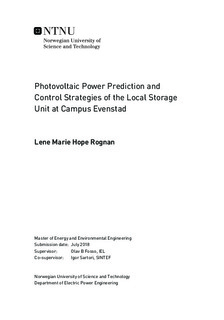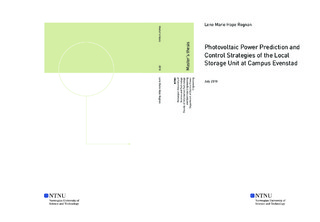| dc.description.abstract | This thesis represents a building block for future model predictive control of a battery connected to a complex energy system consisting of a photovoltaic (PV) system and a combined heat and power (CHP) plant. The complex energy system at Campus Evenstad in Norway is used a case study in this thesis. The aim of this thesis is bipartite: (1) the performance of the PV system is to be predicted, and (2) various control strategies of the battery will be investigated to see the flexibility that the battery may provide for the end-user. Two models have hence been developed: a PV model and an optimization model of the battery. Both models have been developed in Python with the help of the PVLIB and the Pyomo libraries.
Two approaches to estimate the plane-of-array (POA) irradiance on the PV array were tested in the PV model: the dirindex and the erbs irradiance decomposition methods, which are both built-in functions in the PVLIB library. Results showed that the dirindex decomposition method gave the most accurate results. However, results for winter months are highly inaccurate, and hence the PV model should be improved to better predict the PV performance in such months. The model was also tested with various overall PV system efficiencies and surface types indicating how much reflected solar radiation that hits the receiver. An overall system efficiency of 74% and surface type asphalt resulted in the most accurate PV estimation.
The optimization model was solved with three different objectives: (1) minimization of total import of electricity, (2) minimization of spot energy costs, and (3) peak shaving. In addition to analyzing the charge and discharge of the battery, the total cost of import was calculated for each control strategy. When using the battery to minimize the total import from the grid, the battery is not frequently used. The only recharging of the battery that takes place is a result of low demand in times of high PV production. The minimization of the spot energy cost control strategy reduces the energy cost of the imported electricity, but low spot prices lead to an increase in the import peak and hence an increase in the grid tariff cost. The total import cost of this control strategy comes out higher than the total cost of the other two control strategies. The variation in spot prices results in a rapid charge and discharge of the battery. Optimizing the utilization of the battery with the objective of performing peak shaving, the grid tariff, which is determined by the highest import peak in the last 12 months, is reduced. The grid tariff makes up the highest share of the total cost of import, and hence does this control strategy result in the lowest total cost. | |

